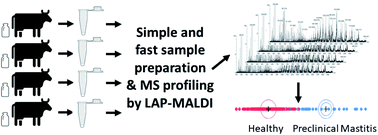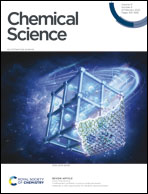LAP-MALDI MS coupled with machine learning: an ambient mass spectrometry approach for high-throughput diagnostics†
Abstract
Large-scale population screening for early and accurate detection of disease is a key objective for future diagnostics. Ideally, diagnostic tests that achieve this goal are also cost-effective, fast and easily adaptable to new diseases with the potential of multiplexing. Mass spectrometry (MS), particularly MALDI MS profiling, has been explored for many years in disease diagnostics, most successfully in clinical microbiology but less in early detection of diseases. Here, we present liquid atmospheric pressure (LAP)-MALDI MS profiling as a rapid, large-scale and cost-effective platform for disease analysis. Using this new platform, two different types of tests exemplify its potential in early disease diagnosis and response to therapy. First, it is shown that LAP-MALDI MS profiling detects bovine mastitis two days before its clinical manifestation with a sensitivity of up to 70% and a specificity of up to 100%. This highly accurate, pre-symptomatic detection is demonstrated by using a large set of milk samples collected weekly over six months from approximately 500 dairy cows. Second, the potential of LAP-MALDI MS in antimicrobial resistance (AMR) detection is shown by employing the same mass spectrometric setup and similarly simple sample preparation as for the early detection of mastitis.



 Please wait while we load your content...
Please wait while we load your content...